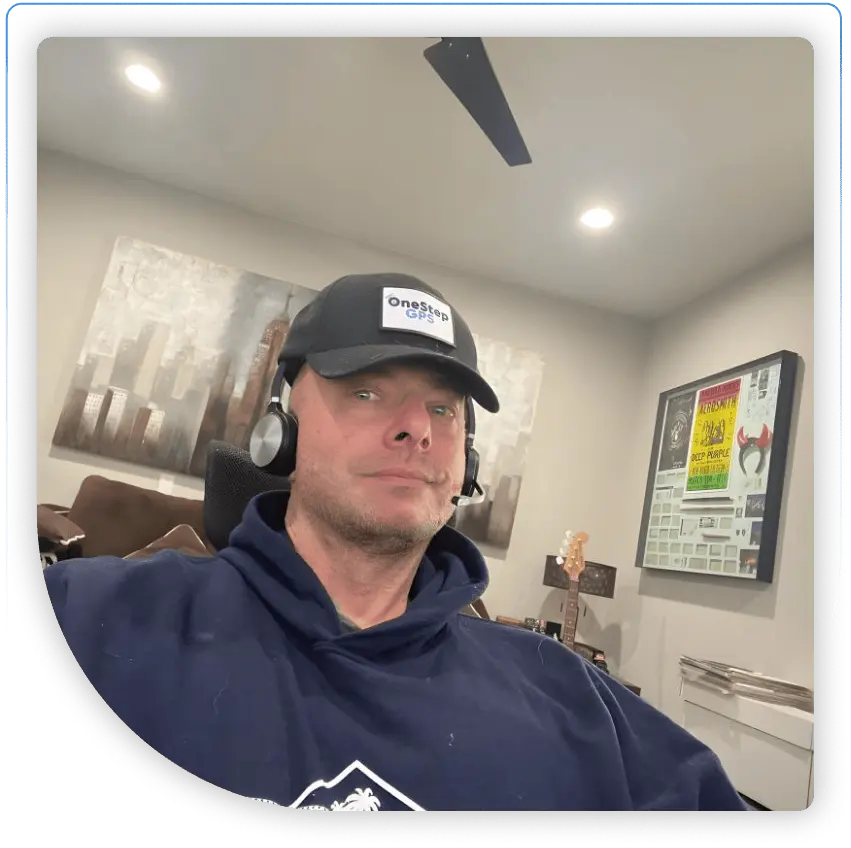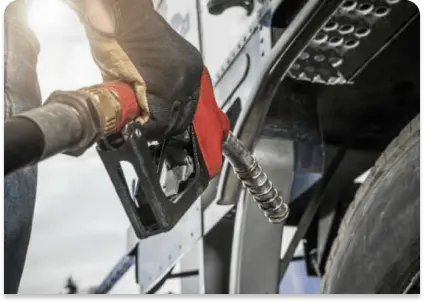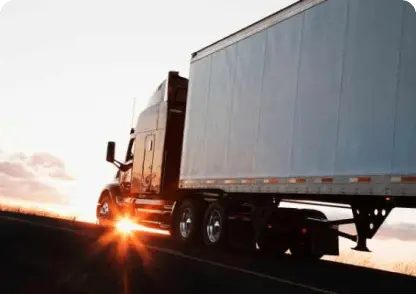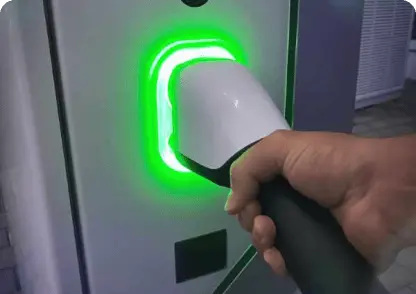
Create a world-class fleet safety program
One Step GPS gives you the power to implement, measure, and improve a safety program that gets your drivers home to their families every time.


4.9 / 5 — Serving over 20,000 fleets
- Driver scorecards report on historical performance for weekly or monthly review
- Live alerts notify you of immediate issues like harsh braking, speeding, and cell phone use
- AI cellphone-use detection alerts managers and drivers in real-time
- GPS-enabled HD video cameras record the road and the cabin simultaneously
- Real-time video allows corrective coaching of dangerous behavior now instead of months after the fact
- 74% consider fleet tracking very effective in improving safety
- 57% reduction in citations
- 25% reduction in insurance premiums
- 38% reduction in total accidents
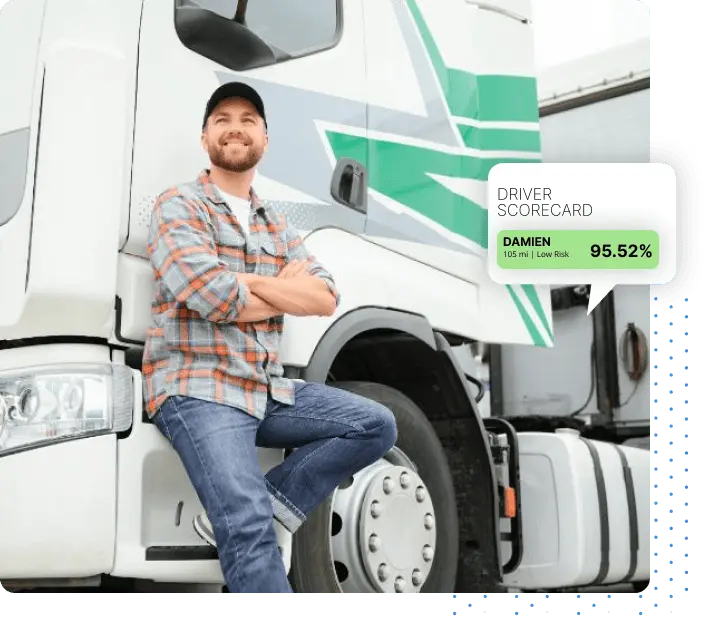
"We use One Step GPS to prevent theft and unauthorized use of our assets, and to recover them quickly if they are stolen." — L.M.

"The video camera is not intrusive or distracting. It records automatically and uploads the data to the cloud. It makes me feel more secure and protected." — J.H.
- In-vehicle alerts warn drivers of risky behavior, so they can correct it as they drive
- Scorecards and live alerts track each driver's performance across essential safety behaviors like harsh braking, speeding, and more.
- Historical data paired with video footage allow safety coaches to commend good driving and base correction on actually observed risk
- Instant cloud storage closes the feedback loop and speeds corrections up so training is current and relevant

"One Step GPS has been a great tool for our fleet management. It has helped us monitor driver behavior, reduce fuel costs, and improve customer service. We also use the driver coaching feature to provide feedback and training to our drivers. It has made a positive impact on our safety culture and our bottom line." — L.M.
One Step GPS essential safety features
App, phone, and email alertsInstantly receive alerts of risky driving behavior.
In-vehicle safety assistanceAI-powered driver assistance helps drivers adjust behavior in real-time. Track speeding, harsh driving, and more
Track speeding, harsh driving & moreLive and historical records of speeding, harsh braking, and many more essential safety behaviors
Dual-facing video for clarityUnderstand what actually happened. Give data-driven coaching that actually works.
Better maintenance, fewer accidentsAutomate maintenance reminders, get real-time diagnostics alerts and keep every vehicle in top shape.
Optimize routing for safer tripsAvoid risky driving environments, plan accurate routes, and find the best alternatives with live traffic views.
App, phone, and email alertsInstantly receive alerts of risky driving behavior.
In-vehicle safety assistanceAI-powered driver assistance helps drivers adjust behavior in real-time. Track speeding, harsh driving, and more
Track speeding, harsh driving & moreLive and historical records of speeding, harsh braking, and many more essential safety behaviors
Dual-facing video for clarityUnderstand what actually happened. Give data-driven coaching that actually works.
Better maintenance, fewer accidentsAutomate maintenance reminders, get real-time diagnostics alerts and keep every vehicle in top shape.
Optimize routing for safer tripsAvoid risky driving environments, plan accurate routes, and find the best alternatives with live traffic views.


One Step GPS seamlessly integrates with route optimization companies, enabling efficient route planning and management. Users can access route times linked directly to Google Maps through their user-friendly portal, providing accurate and up-to-date navigation information." — Several

"One Step GPS has helped us keep track of our vehicle maintenance and service records. We can set up alerts for oil changes, tire rotations, and other routine tasks. It also notifies us of any diagnostic trouble codes or engine issues that need attention." — R.G.
Driver safety FAQs
- Real-time and historical driving behavior, including:
- Speeding
- Hard braking
- Harsh driving
- Rapid acceleration
- Driving outside of defined routes and boundaries
- After-hours driving for theft and misuse
- Device tamper alerts
- Optional dual-facing, AI-powered Dashcam which detects cell phone use while driving
- More!
- Driver's scorecards that show behavior trends and score driving performance for any defined period
- Customizable maintenance alerts to ensure every vehicle is kept roadworthy at all times
- Live engine diagnostics readouts to catch malfunctions and needed repairs before they cause accidents and additional costs
- Lower fuel, maintenance, and operational costs
- Fewer accidents, liabilities, and claims
- Lowered insurance premiums
- Fewer citations
- A better reputation and higher trust from potential and existing customers
- Hard braking events
- Speeding (slightly, moderately, and severely)
- Fast acceleration
- Hard cornering
- Discuss the subject of safety with your drivers, and include them in your safety program from the start. Driver buy-in is the key to creating a safer fleet. Drivers should know and feel that this program is for their safety and well-being because it is.
- Set clear company policies around the critical aspects of driver behavior and vehicle maintenance standards and make them clearly known to every driver. Discuss them with your drivers, answer any questions they may have, and help them feel engaged in this process.
- Gather telematics data and maintenance records to benchmark current fleet performance. In particular, we recommend you benchmark your individual and fleetwide driver's safety behavior (automatically reported with One Step GPS) and two maintenance KPIs:
- On-time completion of preventative maintenance (percentage of preventive maintenance procedures completed on or before schedule)
- Time-to-repair (average length of time from when a needed repair is reported to when it is resolved)
- Establish safety goals among your managers and drivers. Measure and review the approach toward these goals regularly with your drivers. One of the best tactics to encourage driver buy-in and speed the uptake of safety practices is to turn the program into a game and make it fun!Set fleetwide goals for improved safety scores and create a reward program for when they are achieved. Pizza nights, amazon gift cards, and company-wide baseball games are encouraged!Find out what your drivers would like as a reward and get it for them when they meet company safety goals.When the whole team works together, amazing things can happen.
- Set a regular schedule for reviewing safety performance. Focus on reinforcing good behavior. Only correct bad behavior when you have the real-world data to back it up and correct only the exact behavior needed so drivers gain confidence in and respect for your coaching program.
- Using company vehicles for personal use
- Padding time by taking odd routes or making excessive personal stops
- Driving recklessly in company vehicles
- Fuel waste
- Excessive vehicle wear
- Avoidable accidents
- Insurance premiums
- Maintenance oversight
- Moving violations/citations
- Inefficient routing and dispatching
- Compliance violations
- Premature vehicle depreciation
- False claims
- Theft
- Employee misuse
- Payroll and other employee fraud
- The list goes on...




































